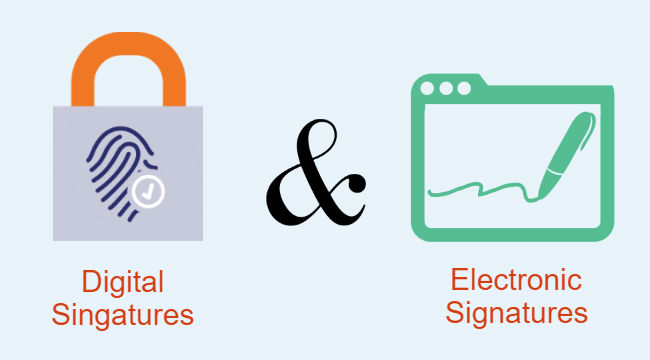



 (11 votes, average: 4.64 out of 5, rated)
(11 votes, average: 4.64 out of 5, rated)Life was so simple 50 years ago, wasn’t it? Less stress, a steadily paced lifestyle, more leg space in the Airlines (tall people will relate better!) and most of all, ONLY ONE SIGNATURE!!! Gone is the simplicity and easiness that came along with those ‘Good Old Days.’
Electronic signatures, E-signatures, digital signatures, biometric signatures…phew! Seriously, how many types are there? It’s too complicated, isn’t it? Worry no more. This blog is just for you. Well, we’re not saying that this blog will change your life, but it will surely help you disengage the gray cells in your brain.
Primarily, there are two types of online signatures – Digital and Electronic. Although there is a significant difference between the two, they’re oftentimes believed to be the same thing.
Well, they’re not.

An electronic signature is an electronic version of the physical, hand-written signature. Just the way you sign your documents, electronic signatures are used the same way. Instead of using a pen to sign a document, you can easily sign documents with just a click or your fingerprint. X`
Unfortunately, everything comes with pitfalls and electronic signatures are no different. Electronic signatures offer a less secure platform. This is because there are no standards or coding techniques involved with them. The receiver cannot verify the identity of the sender.
Documents signed using electronic signatures are highly vulnerable to tampering and man-in-the-middle (MITM) attacks. It means that the document can be hijacked and tampered with when it is “in the air.” Such attacks can turn out to be deadly as far as the secrecy of an individual/organization is concerned.
Another shortcoming of electronic signatures is their non-universalness. It means that unlike the real world, there can be more than one signature for the same person. If you decide to change your signature providing vendor, you may as well lose your old signature. Needless to say, this can cause a few problems.
Digital Signature is another breed of the electronic signatures, the only difference is that it involves the use of a code or algorithm to sign and validate the authenticity of a document. Unlike electronic signatures, digital signatures come under specific standards and a stringent verification process. They not only sign the document using a code, they encrypt data. ‘Secure’ is a small word, encryption makes your documents INVINCIBLE against cyber-attacks.
In order to sign a document using a digital signature, you need to buy a digital certificate first. In order to issue the digital certificate, the issuer must go through a stringent vetting process from a 3rd party certificate authority (CA). This certificate consists of a private key and a public key – known as the ‘key pair.’ This means that the data encrypted using a particular Private Key can only be decrypted using its paired Public Key. The document won’t open if the Private Key doesn’t match with the Public Key. Thus, making the file transfer a thousand times safer.
Realizing the need to protect against such alteration, digital signatures have become a norm for many organizations.
Side-by-side comparison
| Electronic Signature | Digital Signature |
|
|
|
|
|
|
|
|
|
|